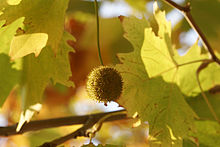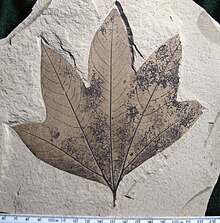Platanaceae
| Platanaceae Temporal range:
| |
|---|---|

| |
| Inflorescence of Platanus × hispanica
| |
| Scientific classification | |
| Kingdom: | Plantae |
| Clade: | Tracheophytes |
| Clade: | Angiosperms |
| Clade: | Eudicots |
| Order: | Proteales |
| Family: | Platanaceae T. Lestib.[2] |
| Type genus | |
| Platanus L., 1753 | |
| Other genera | |
| |
Platanaceae, the "plane-tree family", is a

Description

- Large, sympodial, deciduous tree, speckled bark that sheds in large irregular sheets, leaving a smooth surface that is mottled and pale, persistent bark at the base of the trunk, indumentum with large glandular hairs, multicellular and uniserrate or short with uniserrate ramification (in candelabrum), in stellate fascicles; glandular hairs with unicellular, globular capitulum, cuticular waxes without crystalloids, with rods and plates
- Leaves generally with very variable shapes and nervation, simple, alternate, more or less distichous, isobilateral palmate with three to seven lobes (palmatifid to palmatisect) with whole edges or with glandular teeth (each one with a midvein that broadens towards the glandular apex, where it ends in an open hole), or penninerved and whole (Platanus kerrii), this shape common in young, vernal leaves in other species, vernation folded, with the petiole usually sheathed, enclosing the axillary bud (bud is free in P. kerrii), stipules foliose, large, intrapetiolar, tubular, normally caduceus, in P. kerrii scarious, small, basally fused to the petiole, domatia present, stomata irregularly anomocytic
- Stems with aggregated rays in the xylem, with nodes septilacunar, cork cambium present and superficial, buds covered by single scale
- Plants monoecious, the flowers of each sex in separate inflorescences
- bracteolesamong the flowers
- carpels apocarpous in two or three whorls, imperfectly closed apically, surrounded by large petals, linear stylodious, stigmas internal, decurrent in two ridges, more or less dry, two ovules per carpel but one nearly always aborts, orthotropous, bitegmic, crassinucellated, pendulous, apical to marginal placentation, three or four staminodes3-4, no nectaries
- Fruits in achene, clavate, grouped in a globular capituliform infructescence, each fruit surrounded by long hairs
-
Fruiting body of P. orientalis (Oriental plane tree).
-
Fruiting body of American sycamore (P. occidentalis) with some achenes removed
-
An achene
-
Cross section of an achene with the seed shown in brown
- thin and straight with two linear cotyledons, often uneven
- Pollen in subprolate monads, 16-22 μm in length, tricolpate, sometimes sextarugate, tectate-columellate, reticulated surface, the base layer as thick as the tectum
- Chromosomal number: 2n = 14, 16, 21, 42; x probably equal to 7 or 8
Ecology
Pollination is anemophilous; flowering begins at the start of spring when the new leaves are sprouting. The heads that sustain the fruit normally shed the year after they have matured, during the autumn. Dispersion of the individual fruiting bodies, with their thistledown, is anemochorous (they are sometimes dispersed by water as a secondary mechanism).
The plants grow in cool situations in temperate climates and are frequently found on the banks of rivers and streams. They are totally absent from dry or excessively cold areas.
Phytochemistry
They contain
.Cultivation

The main use for a number of the species is to provide shade in pedestrian areas in temperate regions, particularly the London plane-tree (
Fossils
A large number of fossils of this family have been recorded from the Lower
Systematic position
The
Taxa included
- Theoretical introduction to Taxonomy
The only extant genus, Platanus L., 1753, has the type species Platanus orientalis L., 1753. It is divided into two subgenera: the subgenus Castaneophyllum J.-F. Leroy, 1982, with elliptical, penninerved leaves with small scarious, stipules, that only includes Platanus kerrii Gagnep., 1939, an isolated relict species that represents the genus’ evolutionary basal branch and which is the sister group of the other species, which comprise the subgenus Platanus.
Hybrids

The London plane-tree or hybrid plane has long been considered a hybrid derived from the cross between P. occidentalis and P. orientalis, despite this its origin is not clear. Some experts think it originated in London and others in Spain or even in natural or cultivated hybrid form (or not) in Turkey. The question has not been investigated with modern molecular methods. As a consequence, even its nomenclature is hotly debated, to the extent that anglophone authors deny the priority of the name used in Spain (following Maria da Luz de Oliveira Tavares Monteiro da Rocha Afonso, 1990, see References). The plant is not found in the wild, though it appears in a naturalized form along the banks of rivers and streams.
Hybrid (?) , 1841, nom. illeg.; P. × acerifolia.
Other names proposed for hybrids that are probably synonymous with the above, which is the only name in English, and which represent smaller minorities are:
- Hybrid Platanus × cantabrigensis A.Henry, 1919
- Hybrid Platanus × parviloba A.Henry, 1919
The references consulted do not agree as to whether the fruit is a nucule or achene, the difference between the two ultimately depends on the size of the pericarp and the extent of its lignification. The fruit is dry, indehiscent, monocarpelar and monospermatic.
References
- ^ "Proteales". www.mobot.org. Retrieved 16 June 2023.
- hdl:10654/18083. Retrieved 6 July 2013.
- doi:10.1086/720138.
- .
- Kubitzki, K. (1993). "Platanaceae.". Kubitzki, K., Rohwer, J.G. & Bittrich, V. (Editores). The Families and Genera of Vascular Plants. II. Flowering Plants - Dicotyledons. Springer-Verlag: Berlín. ISBN 978-3-540-55509-4.
- Rocha Afonso, M.L. (1990). "Platanus". S. Castroviejo et al.(Editores). Flora Iberica Vol. II. C.S.I.C. ISBN 978-84-00-07034-2.
- Watson, L. & Dallwitz, M.J. (1992). "The families of flowering plants: descriptions, illustrations, identification, and information retrieval. Version: 29th July 2006". Archived from the original on 3 January 2007. Retrieved 31 January 2007.
External links
 Media related to Platanaceae at Wikimedia Commons
Media related to Platanaceae at Wikimedia Commons Data related to Platanaceae at Wikispecies
Data related to Platanaceae at Wikispecies- Platanaceae in L. Watson and M.J. Dallwitz (1992 onwards), The families of flowering plants Archived 3 January 2007 at the Wayback Machine.
- Flora of North America: Platanaceae
- Flora of China: Platanaceae
- NCBI Taxonomy Browser
- links at CSDL Archived 13 October 2008 at the Wayback Machine
- Map, incomplete for Asia
- Foliage of Platanus racemosa
- Platanus wrightii Archived 19 February 2012 at the Wayback Machine
- Drawing of Platanus mexicana
- Female inflorescence of Platanus rzedowskii[permanent dead link]




